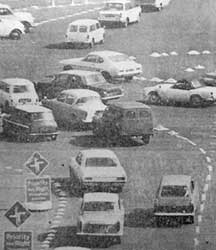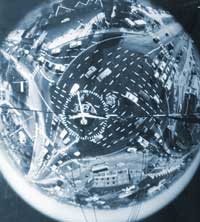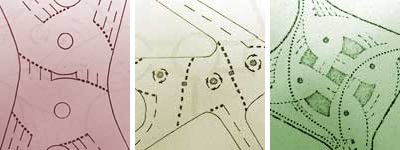There is a story that has travelled incredible distances and, perhaps more than anything else, given the unassuming Wiltshire town of Swindon cause to be discussed across the world. It's not a famous person or a particular achievement. In fact, it's far more mundane than that: it's a roundabout.

The Magic Roundabout is a fabled, almost mythical entity discussed in hushed tones by American road enthusiasts already wary of Britain's many fast, multi-lane roundabouts. Stories of it are swapped with fear and trepidation among those planning a trip to Swindon. Guide books that would otherwise have no reason to mention the place find room for a paragraph or two when this little junction is concerned.
Why? Well, because it's the roundabout that goes the wrong way, of course!
What is it?
In Swindon town centre, just next to the local football stadium, is a junction where five roads meet. Until the 1960s it was a standard roundabout - the usual British way of dealing with unusual multi-directional junctions - but even then it had traffic problems.

Thanks to a rather daring bit of design work, it is now a "Ring Junction": a vast skidpan of tarmac on which are painted five mini-roundabouts, one for each approaching road. They are linked by two-way roads forming a ring. Therefore, approaching it, you can turn either left or right on to the "roundabout" and proceed around it in whichever direction provides the shortest route to your exit.
You can also spin round and round in the wrong direction, if the idea of going against usual road convention gives you a sort of thrill. (I would never, ever be caught doing something so juvenile, of course.)
Standing at the side and taking in this majestic sight - or indeed driving up and waiting to join it - gives the onlooker a panorama of vehicles all swirling and swooping past each other in what appears to be randomised, terrifying chaos. Its name as a roundabout was County Island, changed to County Islands when it grew five more, but its appearance from the sidelines is so unearthly that the nickname "Magic Roundabout" stuck very quickly. It has now been made official and appears on direction signs on the approaches.
How does it work?
The logic behind the junction design is surprisingly simple. Take a look at its layout from above, and after your pulse returns to normal, you can see it's quite logical.

The most important element is, of course, that it works both ways. Because traffic can choose the shortest path between its entry and exit points, it spends less time on the junction. One of the most common movements - from Fleming Way to Queens Drive - now involves travelling about half the distance as it did when this was a conventional roundabout. And if traffic can get out more quickly, that adds up to fewer vehicles clogging up the junction at any one time.
The trade-off is that there are now a much greater number of points of conflict - places where one stream of traffic crosses another. This effect is offset by a simple priority rule on every approach to every mini-roundabout, which means that no vehicle should be held up for very long at any "give way" line. Additionally, every approach has space for several vehicles (usually three but sometimes more) to wait alongside one another: that way, when there is a gap and it's safe to move off, several vehicles can all go at the same time.
It looks like utter mayhem from the sidelines, but it's actually incredibly controlled. Traffic keeps moving almost all the time, waiting only a few seconds to join each mini-roundabout and thus steadily travelling at low speed across the junction. A normal roundabout would involve long waits to join; signals would involve bursts of movement and long enforced stoppages. As a result, it has been calculated that the Magic Roundabout has a greater throughput of traffic than anything else that it would be possible to install in the same space. Magic indeed!
How was it created?

Mini-roundabouts were developed by the Road Research Laboratory in the early 1970s as an experiment into whether the success of the priority-to-the-right rule at larger roundabout junctions could be applied to locations where there wasn't enough space to install a full-size roundabout. By summer 1971, 33 were in use across Britain.
The exercise was, at first, nothing more than an attempt to adjust the priorities at urban junctions to maximise traffic flow. However, one RRL researcher, Frank Blackmore, realised that something much more interesting was going on. The design that was necessary in these constricted places, a very small central island and approaches that widened rapidly just before the roundabout itself, was actually providing better throughput of traffic than a conventional roundabout.
Trials of the new junctions - including "small roundabouts" where a fixed central island was only a few metres across - went incredibly well. At one experiment at the RRL's own test track (shown left), capacity was improved by 25 to 35% simply by reducing the roundabout's central island to 3m (10ft) diameter.
Blackmore pursued this discovery, noting that the design was also superior to signalised junctions, following a Peterborough experiment where an extra 1,000 vehicles could be handled every hour by a new small roundabout at a previously signalised T-junction. He started to wonder if several small roundabouts could be linked to improve more complex junctions. The first double mini-roundabout - now a fairly common sight - was at the southern end of the Truro Relief Road in Cornwall. Its signage was complex, but all the same, it worked (and, in fact, it still works on the same spot today). What if three roundabouts could work the same way? What if more could?
The first Ring Junction was installed to replace an existing large roundabout in Colchester and, like the four-way design above, had a square central island. Traffic turning left or going straight ahead went around the outside as usual, and "wrong way" circulation could only be used to turn right. Really it was still a big roundabout with gaps in the central island; the RRL called them "unhooked" right turns. Unfortunately, its accident record was terrible: it proved much more dangerous than the congested roundabout it replaced, and after fiddling with road markings and signage, the experiment was abandoned, with the junction returning to its previous state.

Blackmore didn't give up, though, and in 1972 gave Britain a new design of Ring Junction. It was supposed to be in Birmingham, but the Council there was unable to fund the scheme, and so the RRL was invited to try its new design at a congested roundabout near Swindon town centre. For the first time, traffic could flow both ways right around the central island, meaning that if one side was congested, the other side could take up the slack. After a few days of Police control, in which time RRL researchers logged events from a crane-mounted camera, the experiment was branded a success.
There was an initial flurry of excitement, with more Ring Junctions built at Hemel Hempstead, Denham and Sadler's Farm near Southend. The idea has lost favour now, despite offering greater throughput than any other design for a flat junction. They also have an excellent safety record, probably because all traffic is moving too slowly to do any real damage in the event of a collision. But the Magic Roundabouts (er, sorry, Ring Junctions) that do exist are still doing good service. County Island is one of the few places where the jams have never really returned despite forty years of traffic growth.
What's it like to use?
Despite having been voted the seventh worst junction in the UK, the Magic Roundabout's bark is worse than its bite. It looks difficult to negotiate and the direction signs on its approaches are nothing short of intimidating. But all it asks of any driver is to be observant and to always, always, always give priority to traffic coming from the right.
The only other thought needed is deciding which way to go in order to reach your exit. Left, straight ahead, left again? Or right, left, left, right? The junction is actually small enough that motorists can keep sight of their exit as they travel through it, so it's hard to get lost. And the real secret is to stop thinking of it as one junction, because it's not. It's really just five mini-roundabouts that happen to be close together. Deal with them one at a time, ignoring the rest, and you too will come to be touched by Swindon's magic.
Phil Deer is a fan of a Magic Roundabout in Colchester:
"Good to see the Magic Roundabout given the credit it deserves. There's a similar junction in Colchester - the Greenstead Roundabout. Named after the housing estate that borders it, the Greenstead Roundabout was a five-way standard roundabout that was the bane of the commuting lives of anyone living to the east of Colchester.Traffic lights and widening did nothing to improve matters and so, in the early '90s, the council installed five mini-roundabouts, similar to the Swindon model. Since then, whilst there are still snarl-ups at peak times, traffic flows have been much improved and journey times sped up as a result."
It's quite surprising that Ring Junctions were still being installed as recently as the early 1990s - perhaps there's hope for a revival yet!
Comments
Couldn't leave the intersection for 15 years? ))
Thank you for this post and the whole website - I have long been fascinated in Colchester's magic roundabouts & came here (as a member of the SABRE forum) as I saw a reference to this.
On this occasion I am prompted by comments and photographs in a Colchester reminiscence Facebook group - I am interested to read more about the development of the Colchester scheme.
star
Having been a long-term (50 years) road-geek and long-term lurker then member of Sabre, I became aware of Swindon's Magic Roundabout around 20 years ago and was intrigued by it. Still being at that time a fan of roundabout junctions (less so now that I live in Australia, and having seen how well traffic signals can work and how badly UK roundabouts perform under stress) I longed to visit. I finally did that around 2012, and was fascinated and impressed to see it in action. I parked up to observe the traffic for a while before trying it out myself, and was then pleasantly surprised to find that it was not too daunting by about the third pass! (I imagine a newcomer though, with no advance warning, would be horrified and freeze for a while at the first give-way line). Still, much as I admire the daring to proceed with it, I simply cannot believe that it can pass more (peak) traffic than a modern well-designed signalised intersection occupying the same footprint. Incidentally, if I were to be the designer, I would probably stop-up one of the 5 roads to simplify matters.
hi i am 58 i have lived in west bromwich b70 all my life and at the end of shaftbury road b70 we to have an island where you drive round it in either direction its been like that ever since it was there
Is that because of how the island was designed or just typical West Midlands drivers ignoring road formats to get to where they're going and beat the cars in front? ?
I think these are a good idea, but do have some issues. The main one being that, when busy, there is always the "lane change" conflict that comes about. That is, for example, when doing, say, right, right, left at a sequence of three minis, there will be other vehicles that have entered at no2 and want to exit no3 to the right. So, obviously, major vigilance is required and it works, but risks are higher that others are not so careful!
Peter Freeman You say ‘I simply cannot believe that [the Magic Roundabout] can pass more (peak) traffic than a modern well-designed signalised intersection occupying the same footprint’. Do you have any evidence for this belief?
In the article it says that, in the course of the development of the mini-roundabout in the 1970s, ‘one RRL researcher, Frank Blackmore...[noted] that the design was also superior to signalised junctions, following a Peterborough experiment where an extra 1,000 vehicles could be handled every hour by a new small roundabout at a previously signalised T-junction’. The article also notes that the Swindon Magic Roundabout ‘is one of the few places where the jams have never really returned despite forty years of traffic growth’.
I’m prepared to be persuaded that a ‘modern well-designed signalised intersection’ could pass more peak traffic, but I would like to see the evidence.
Magic Roundabouts work where there are multiple - 5+ routes to deal with. To bring all those together requires contorted signal timings, significant times lost intra-green and, unless you're going to make it a barrier to pedestrians, more time lost allowing a complete pedestrian phase rather than requiring pedestrians to cross every road in stages.
Traffic lights are also more crude - they have some idea of traffic, but not to the same degree as a driver. Both at Swindon and Hemel Hempstead before you need to commit to lanes you are given a view across the junction so you can travel a longer way around if there is congestion on one side. This is especially important at both junctions because the joining roads all have different capacities and non-linear demand. A MR automatically optimises itself for changes in demand. Football stadium kicking out? Football fans can travel both ways round the roundabout for the hour or so needed. Much more civilised than around here where people turn the "wrong way" onto less busy roads to avoid the queue, then do abrupt u-turns.
There's also just the driver factor. With astute driving you rarely need to stop on a Magic Roundabout. As Chris says, once you actually try one they're intuitive. Each mini-roundabout only has three entrances, so you only need to decide if you are going left or right and get in the appropriate lane. Because at the previous roundabout the driver alongside you will have chosen the other option, changing lanes is not a problem because they will have left the roundabout.
As long as you know what exit you are taking (which is ordinarily only every first, second or third) and treat it as a simple task of getting in the left or right lane at each roundabout, then it's very easy.
There are a couple of flies in the ointment, such as when they close of exits as at Hemel but hey, it still chugs along alright :)
Sir,I like all over the developed system of uk.
Magic Roundabout I have been analyzed 20 years for signal free digital traffic system.By this system various transport shall automatically flying in 5 road 10 lane and 10 road 20 lane 24 hours without traffic signal.By this system no traffic jem will be seen and we will be preserved our valuable time ,life and wealth.
I'd heard of the magic roundabout from a friend whilst I was living in South Wales. Long before I actually started driving. Completely forgot where it was and never gave it a second thought until years later, working as a lorry driver, going into Swindon and suddenly being confronted by it in all it's glory.
Luckily for me, it was a little before 4am so there was no other traffic and we just went round no drama, whilst taking up pretty much every lane available ?
Not looking forward to the day where I have to go back in a wagon during rush hour though!
As a roads-using educationalist (i.e. driving instructor) who's slowly learning about other countries' traffic infrastructures, I love the simplicity and efficiency of UK designs. From the signage and markings to the junctions and uses of colour-&-contrast, they seem about as good as it gets. Modern detection software can optimise older-generation features (such as pedestrian controlled crossings) yet nothing quite satisfies like the auto-regulation of the water-wheel model Frank Beardmore exploited. Perhaps we should in fact credit Napolean, given the overall efficiency of moving armies along radial routes ("à la parisienne"), then final short distances along chords.
If you have ever seen the 1985 movie European Vacation with Chevy Chase they get trapped in Piccadilly Circus because the can't deal the roundabout. Imagine what would happen if they came across this baby.
I accidentally encountered this roundabout for the very first time, without any prior knowledge of its existence, and for me, it was extremely difficult situation to navigate. I will be surprised if this is the best solution to such a complicated junction problems.
Add new comment
Picture credits
- Photograph of chevron sign in the middle of the Magic Roundabout is taken from an original by Steve James and used under this Creative Commons licence.
- Image of Magic Roundabout with sign taken from an original by Chris Downer, used under this Creative Commons licence.


There's a "magic roundabout" by Hatton Cross tube station in London (just inside the Southern perimeter of Heathrow Airport), and it works very well indeed. In spite of it being a major artery into the airport and having a very busy bus station adjacent to it, I've never seen it congested or clogged up (and I used it almost daily for about 15 years before moving out of the area).